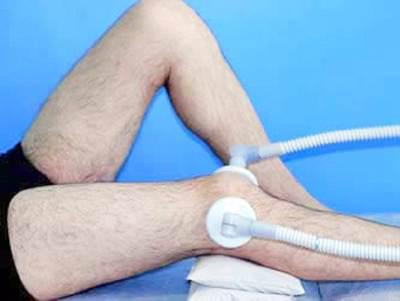
The 'I-Assist' is a surgical guidance system designed to improve the accuracy of a total knee replacement. It not just assists the surgeon in aligning knee implants to each person's unique anatomy but also provides a personalized fit and truly tailor-made total knee replacement. The outcome is very predictable as perfect alignment is achieved intra operatively. The implants themselves are not custom built.
How it works:
This electronic device incorporates latest guidance technologies into a half palm sized electronic display. Some of these technologies are also inbuilt in latest smart phones. The LED lights on the display are similar to traffic signals. A green light means the position is acceptable and a red one indicates scope for improvement. Thus the surgeon can align and validate implant positioning during total knee replacement. As the device is anchored in the operating field itself, it doesn't require shifting of the surgeon's gaze. He doesn't have to remove his visual focus from the operating field. Earlier navigation systems require the back and forth transfer of the surgeon's gaze from the operating field to a computer monitor elsewhere, several times intra-operatively.
The device integrates into the operation by requiring no complex imaging equipment and additional surgical incisions. It is compatible with the company's own product line of primary knee replacements.
History of navigation systems in total knee replacement
The goal of the surgeon during a total knee replacement is to get neutral alignment.. However, studies have shown that even experienced surgeons don't always achieve this perfection.
Hence computer navigation systems were introduced about a decade ago to achieve perfect alignment. In this system, pins were drilled in the thigh and leg bones away from the knee. These pins were attached to sensors. The sensors relayed information to a processor located elsewhere. The monitor of the processor displayed the accuracy of the bony cuts and bony alignment. Based on these, the surgeon could intra-operatively fine tune the cuts and positioning to get perfect alignment. As mentioned previously the surgeon had to shift his gaze back and forth from the operating field to the computer monitor located elsewhere. This computer navigation system also requires intensive capital investment.
A different approach toward this goal was adopted with 'Patient specific instruments (PSI) '. This required additional pre-operative imaging. The images were transferred electronically to engineers elsewhere. The engineers used Computer aided design to manufacture custom fit cutting tool for each patient. These patient specific instruments were shipped to the surgeon after an interval of a few weeks. Hence there is a time lag involved between the planning and execution in this process. Many patients don't want to wait. This is where the new technology comes into picture.
The I-Assist system improves on previous navigation technology.
The main component of the I-Assist knee guidance system is a disposable device that can be procured as needed. No capital equipment investment by the hospital is necessary.
Its features are
· It intuitively integrates with the surgeons' conventional instrumentation for total knee replacement.
· No pre-operative imaging is required.
· No wait time for the patient and the hospital.
· Less invasive procedure to the patient.
Who benefits?
It benefits everybody involved:
· Surgeons' benefit as it saves them more time unlike prior navigation technology.
· Hospitals save on additional costs by eliminating pre-operative imaging and capital investment.
· For the patient, it is less invasive and guarantees accuracy.
Which type of knee replacement patients' benefit most from this technology?
It is of great value primarily to young patients undergoing total knee replacement. The durability of a knee replacement is dependent upon among other factors, the alignment. As younger patients will survive longer after a knee replacement, it is crucial to get the first knee replacement right. This will reduce the need for a redo or revision knee replacement. Revision operations are difficult and expensive.
A sizeable number of young patients have additional complications in the leg that make a knee replacement difficult. Patients from Asia and Africa present with malunited thigh and leg fractures secondary to a previous accident. They have developed post traumatic knee arthritis as a result of these accidents. Bony deformities within the knee and outside preclude use of all previous modes of instrumentation.
· The use of conventional instruments which rely on intact straight bones is impossible.
· Conventional computer navigation is also inapplicable as it requires intact bone within the knee joint.
· PSI is also impossible to design with bone loss and extra articular deformities.
It is vital to get perfect alignment as there is a positive correlation between accuracy and long term survivorship of the implant.
Leave a Comment